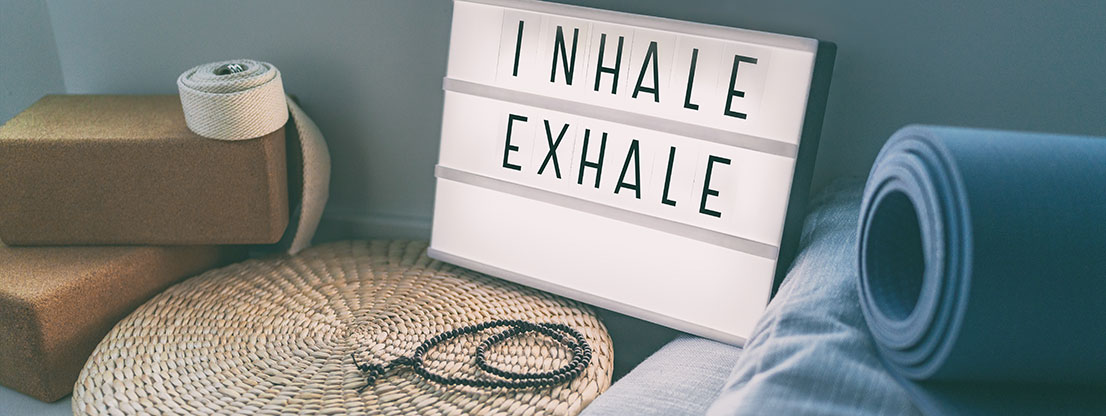Learning to meditate seems unspeakably difficult at first sight to many people. When they only think of it, images of shaven-headed monks in rough mountainous landscapes, who for years prayed for enlightenment in the most uncomfortable dislocation, come to mind. But meditation is so much more – and so much easier. Anyone can learn meditation. It is a wonderful method to face the challenges of everyday life calmly and attentively. In this article we will show you 4 simple breathing techniques with which you can easily take your first steps in the world of meditation.
Breathing techniques for calming down – Why learn meditation?
In… out. In … out. You usually don’t even notice it, but your breath is your constant companion. During sports it provides you with an extra portion of oxygen so that you can perform at your best. When you sleep, on the other hand, you breathe deeply and calmly. The so-called vegetative nervous system ensures this.
Without you having to do anything for it, your breath adapts to your life. The trick is that it works the other way round, too. When you breathe relaxed, your muscles relax – an effect you can use when you are restless or stressed. If you calm your body through conscious breathing, this has an additional positive effect on your mind. If you concentrate on a breathing technique, you are completely in the here and now, focus only on yourself and can thus, for example, create mental distance in stressful situations – this is exactly what happens in a meditation for calming down. [1]

Mindfulness in everyday life: Exercise 1 – Observing your own breath
Learning meditation is easy and starts with simple exercises. Often it is about paying attention to yourself and your surroundings and thus sharpening your sense of what is going on around you and inside you.
For example, sit comfortably in a quiet place, close your eyes and take a few deep breaths in and out. What does the air feel like when it flows in and out through your nose? Let your breath slowly become deeper and deeper. Feel it and pay attention to the smallest details. Does the air in your nose feel warm? Do you feel the breath more in your chest or in your stomach? Observe your respiratory flow benevolently. You don’t need to force yourself, because breathing happens all by itself. This breathing exercise is particularly suitable as an introduction to meditation, but can also serve as a prelude to other techniques. [2]

Richtig atmen: Übung 2 – Bauchatmung
Deep abdominal breathing supplies your body with plenty of oxygen and relaxes your muscles. In everyday life, we often breathe shallowly because correct breathing is difficult in awkward positions such as the curved “desk position”: the abdominal wall is pressed in, the diaphragm has to work against this resistance and the result is inefficient breathing, which supplies us with less oxygen than we actually need – which in turn causes the breathing rate to rise to compensate for this deficiency.
To practise deep, healthy abdominal breathing, you can lie on your back on a not too soft surface and place your legs at an angle so that your feet are on the floor. Now place your hands on your abdomen with your fingers spread so that you cover the entire area between the lowest rib and the pelvis.
Breathe deeply and in a controlled manner and observe how your stomach moves: when you breathe in, it bulges outwards, when you breathe out it flattens again. As with the first exercise, concentrate on what you are feeling – an easy meditation for beginners. After some time, once you have internalised what the correct abdominal breathing feels like, you can consciously incorporate it into your everyday life again and again until it becomes a healthy and beneficial habit. [3]

Relaxes in a few minutes: Exercise 3 – Exhale twice as long
If you are tense or stressed, this is usually evident from your physical reaction: your jaws tense up, your muscles harden, maybe your eyebrows tighten. Mindfulness exercises like the previous ones help you to pay attention to such signals from your body. If you notice the signs, you can use a breathing technique to counteract them.
A simple breathing technique for relaxation is one-to-two breathing. You breathe out twice as long as you breathe in for a few minutes. This makes you relax involuntarily and counteracts your excitement and tension. The great thing is that you can use this technique anytime and anywhere, even when people are around you.
With a little practice, you can lengthen the breathing cycle: for example, if you start with 3 seconds inhalation and 6 seconds exhalation, you can increase to 4 seconds inhalation and 8 seconds exhalation over time. The more often you practice this technique, the faster you can balance yourself with its help and the more effective your meditation becomes.

More calm and focus: Exercise 4 – Boxing breathing
Boxing breathing is a breathing technique where you breathe in and out evenly, holding your breath between breaths. The regular rhythm calms your heartbeat and you will reach a balanced, focused state of mind after only a few breaths.
Begin the breathing technique by letting all air escape from your lungs. Then the first breathing cycle begins: Breathe in for 4 seconds and hold your breath for the same amount of time. Then exhale for 4 seconds and hold again for 4 seconds. [4]
In the beginning this meditation is unfamiliar to beginners and you might get a little dizzy, so you should do the exercise sitting and listening to your body right at the beginning. If you get confused with counting, you can create a picture in your mind’s eye: imagine a square whose lines you “breathe along” evenly. Each horizontal line represents an element of the breathing technique, i.e. inhalation or exhalation, and each vertical line represents the pause in breathing. You need 4 seconds for each line. With a little practice you can try a 5 second rhythm later.

No fear – you are not alone
“What was that again, four seconds of inhalation … wait, should I sit or lie down now?” Beginners sometimes have difficulty concentrating fully on their breathing. If that’s how you feel, don’t worry – there is no right and wrong in meditation. Stay calm and allow yourself to see a mental digression in a relaxed way.
And you are not alone: guided meditations help you to focus better and guide you in relaxed breathing. An experienced meditation trainer can help with this or an app like sonamedic: Simple basics of different breathing techniques are part of many sessions and work excellently in combination with the soothing background music. The voice of the speaker gently guides you back to meditation time and again. Thus your thoughts come to rest. You can fully concentrate on your breathing and experience its beneficial effects on body and mind.
Sources
[1] Techniker Krankenkasse: Meditative Atemübungen für mehr Entspannung im Alltag (3/4). Datum des Zugriffs: 21.10.2020. https://www.tk.de/techniker/magazin/life-balance/aktiv-entspannen/meditative-atemuebungen-2007104
[2] Hartmann, Corinna: Die Entschleunigung des Atems in: Spektrum Psychologie, 4/2019. https://www.spektrum.de/news/die-entschleunigung-des-atems/1636754
[3] HKK Krankenkasse: Entspannt durch Bauchatmung. Datum des Zugriffs: 21.10.2020. https://www.hkk.de/themen/entspannung-und-stressvermeidung/bauchatmung
[4] Freudiger, Julie: Kein Stress! Atemübungen zum Entspannen. Datum des Zugriffs: 21.10.2020. https://www.sanitas.com/de/magazin/aktiv-sein/stress-und-entspannung/richtig-atmen-fuer-mehr-entspannung.html




